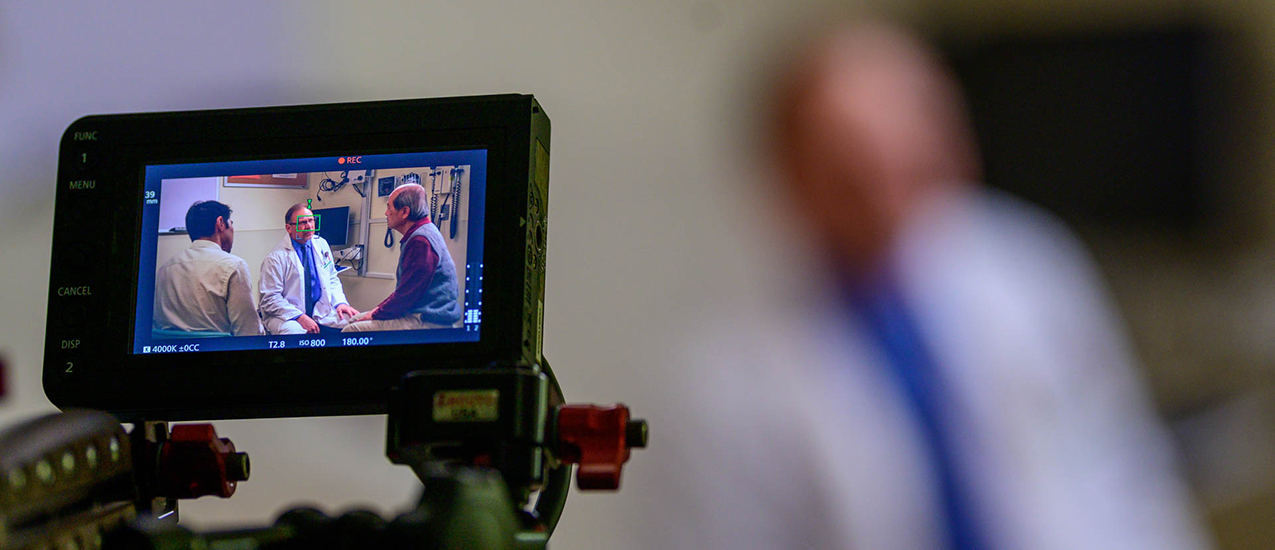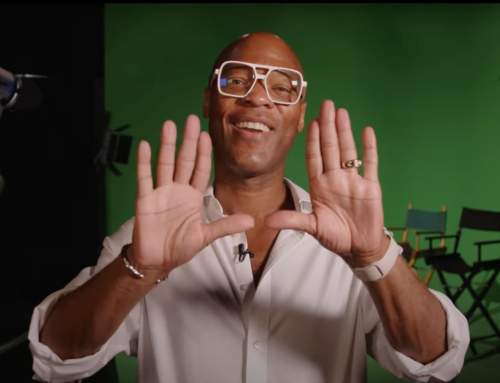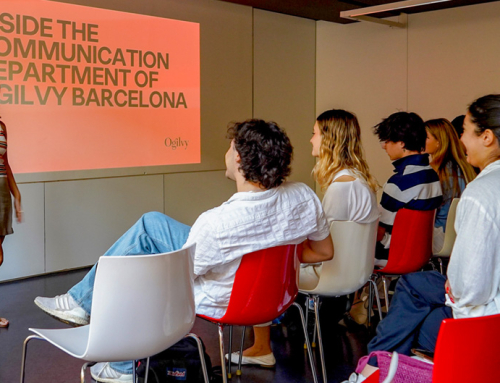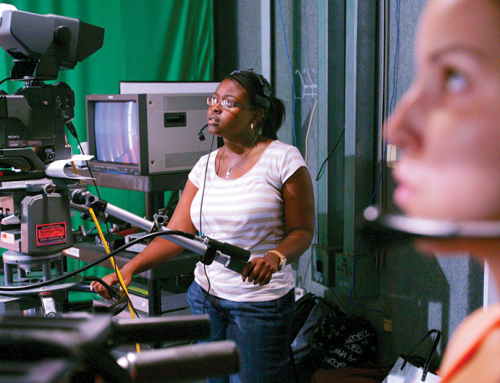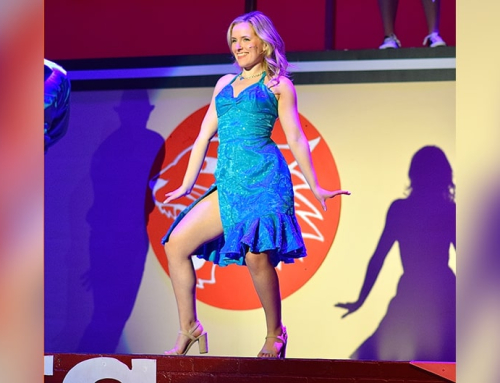By Karina Valdes
After great success with their last virtual reality (VR) project, the Ohio Department of Medicaid commissioned a new original 360 VR series, Medicaid Care Experience Simulation (MCarES). The series addresses health equity and cultural humility for the LGBTQ+ community, elder abuse in older adults with disabilities, and maternal infant health and intimate partner violence.
Rafal Sokolowski, a recently hired assistant professor in the Department of Cinematic Arts, took the helm in creating and developing the series, working as the show runner to conceive the stories and produce scripts for the 18 original episodes. He previously taught directing, film production, and writing at the Ohio University School of Film.
“These series simulations will be used for training health providers in how to approach specific demographic groups. Research from the Ohio Department of Medicaid shows that there are demographic groups that do not benefit equally from the health system that Medicaid provides,” said Sokolowski.
The $6.4 million grant awarded by Medicaid was administered from the Ohio Colleges of Medicine Government Resource Center. Ohio University was the principal investigator and worked in conjunction with Case Western Reserve University and the University of Toledo.
Sokolowski spearheaded the creative aspect of the project and worked as the show runner where he was responsible for creating the stories and characters, conducting research and interviews with patients and medical healthcare providers, as well as subject matter experts to distill the stories. He also led the writer’s room and wrote 18 original scripts for the series. Elizabeth Beverly, from Ohio University Heritage College of Osteopathic Medicine, was the principal investigator supervising the medical research aspect of the project. Matt Love and John Bowditch at Ohio University Game Research and Immersive Design (GRID) Lab were the co-investigators, supervising the technical and production aspects.
Ohio Health partnering with researchers from the Ohio University Heritage College of Osteopathic Medicine, Case Western, and the University of Toledo, investigated why certain demographic groups do not benefit equally from the services provided by the Ohio Department of Medicaid, how to potentially mend this issue, and, then, how to develop the most effective tool that would allow providers to interact with these demographic groups in a compassionate manner, while also providing excellent medical care.
Sokolowski created the storylines and characters based on the research.
“Part of my work was to interview patients and listen to real stories and then convert them into dramatic stories that would then be used to immerse the healthcare providers in their patient’s lives, and to meet the larger context of who are these potential patients that are coming to their offices,” said Sokolowski.
He spent many hours interviewing patients and healthcare providers to pinpoint where the gap between patient, doctor, and available healthcare is happening.
“We interviewed a lot of patients and healthcare providers to get a sense of where is that gap and how can we design stories where the healthcare providers can then immerse themselves in these simulations and have a-ha moments that lead to better care for their patients,” said Sokolowski.
The interviews were comprehensively analyzed to develop original stories focused on communities that experience implicit bias when accessing healthcare.
“I had a lot of meetings with patients who provided their personal experience of what they went to a healthcare provider for, and how this interaction with healthcare providers either turned them off or allowed them to fully benefit from what Medicaid wants them to benefit from,” said Sokolowski.
The stories center around Dre, a non-binary person seeking pregnancy; Mr. Chen, an 80-year-old Chinese American, living with his bi-racial family, and experiencing elderly abuse and neglect; and Ana Luisa, a single mother and a recent Mexican immigrant experiencing intimate partner violence. Sokolowski and the team created 18 stories, six for each character. Each character was developed after extensive research.
“With the elderly experiencing domestic abuse and negligence, the research found that this is a demographic group that falls through the cracks. There are a lot of cases that were not flagged, that were missed, and, in retrospect, providers go back and say, ‘Oh, there were things that were said in the initial interviews with these patients that somehow we did not latch on to’,” said Sokolowski.
The LGBTQ+ demographic is another group struggling to receive adequate healthcare.
“The research shows that they are turned off because there is implicit bias. They walk into the healthcare office and see signs and posters that are heteronormal in terms of their messaging and they are, at times, misgendered,” said Sokolowski.
The final character in the series experiences domestic violence at the hand of her partner. For this series, Sokolowski spoke with patients, healthcare providers, and social workers to gain an understanding of the process of reporting domestic violence. The research found that hospitals and social workers are caught in a nebulous system, oftentimes leaving the patient without proper resources.
“Medicaid wanted to investigate this and they wanted to understand why and how this can be improved on their end so that they can work with the hospital’s social department and with the social workers to somehow make sure that victims don’t go back home to abusive circumstances,” said Sokolowski.
The three stories were filmed in 360 VR to truly immerse the viewer in the homes and lives of the characters.
“A healthcare provider puts on this headset, and, right away, they are inside the house of that person. They, for example, can see how violence arises and gain an understanding as to why a patient is not upfront with this and says ‘hey, I’m being abused and I need help.’,” said Sokolowski.
The first four episodes of the six-part series for each character show the life of the patient and interactions with healthcare providers. The last two parts are simulations that place healthcare providers taking part in this immersive exercise in two roles, the first being that of a provider conversing with their VR colleague who reports a case, but the case was purposefully written by Sokolowski and the team to be misguided.
“And, so now Medicaid is asking their immersed provider to somehow in a friendly way provide correction to the VR colleague. ‘Hey, you know you could have asked this question or, instead of judgment, maybe you could have just asked or recommend this resource.’ and it becomes this kind of first-person training,” said Sokolowski.
The last episode mimics an earlier one where the patient met with a healthcare provider, but did not receive appropriate care. In this episode, the healthcare provider is played by the person taking part in the immersive exercise and they now have the opportunity to conduct the visit again, but this time with a more empathetic approach.
“This scene kind of unfolds in a way that the healthcare providers have a chance to experience a situation where they’ve approached it in a way that is helpful. Right away, they are positively reinforced because the patient starts responding in a different manner and starts opening up and says, ‘Oh, wow! I didn’t know that I could tell you this.’ All of a sudden, this whole visit goes in a very different direction,” said Sokolowski.
Each of the three stories end with an epilogue detailing how the positive encounter with the healthcare provider changed the course of these people’s lives.
“The point of the series is for people to eradicate implicit bias and acquire effective tools for how to deal with situations that are difficult. The series is not to condemn the practices of healthcare providers. It’s really to provide additional tools and to use the vehicle of empathy for both sides, while recognizing that this is a challenging issue,” said Sokolowski.
The project is now in post-production and will be used as one part of an intervention conducted by the Ohio Department of Medicaid that includes trainings, conversations, and printed materials.
“The first part of the training is preparation for this experience so that people who put on this headset are not just thrown into this experience unknowingly. They are being warned about some content being upsetting, especially in those series that are tackling more heavy things and present graphic visuals as well,” said Sokolowski.
Following the VR experience, healthcare providers are then involved in a discussion about what they viewed led by individuals who have been trained on running the module.
“There is a curriculum of how one unfolds a discussion afterwards. The talking points have been developed parallel to writing the scripts. So, as I worked with my team of writers, building these stories, these characters, writing in issues, problems, and challenges into them, we were compiling potential talking points for the people who will later disseminate this training,” said Sokolowski.
The project is expected for distribution in 900 healthcare centers including hospitals, clinics, and medical associations. They will also be available on YouTube.
“Each story has its dramatic arch and engaging characters that reveals a lot about these people that is mostly hidden from their doctors and nurses,” said Sokolowski. “It taps into the strength of VR, giving the viewer a privileged, all-around, and unedited access to the character, and combines it with the power of character-driven cinema. That’s where my work comes in, in telling a compelling story. The fusion between VR technology and cinematic narrative is very exciting for me,” added Sokolowski.
Sokolowski is a passionate film teacher and an award-winning film and theatre director whose pedagogy comes directly from his professional work as a director, writer, and creative producer. His practice is rooted in the neo-neo realist narrative. Since 2014, he taught directing, film production, and writing at the Ohio University School of Film. Previously, he taught at York University, Ryerson, the National Theatre School of Canada, the College of Communication and Media in Warsaw, LIFT, and Soulpepper in Toronto. His latest feature, “22 Chaser,” was theatrically distributed in the U.S. and Canada and is available for streaming on Paramount+, iTunes, and Amazon Prime.
